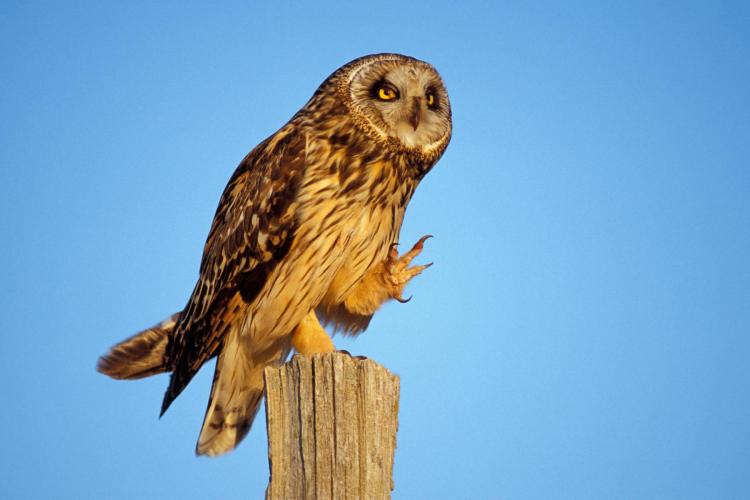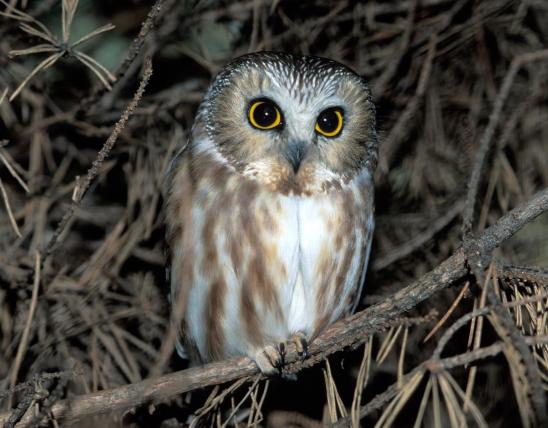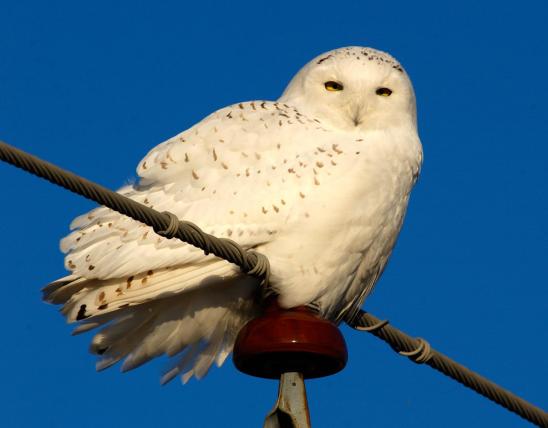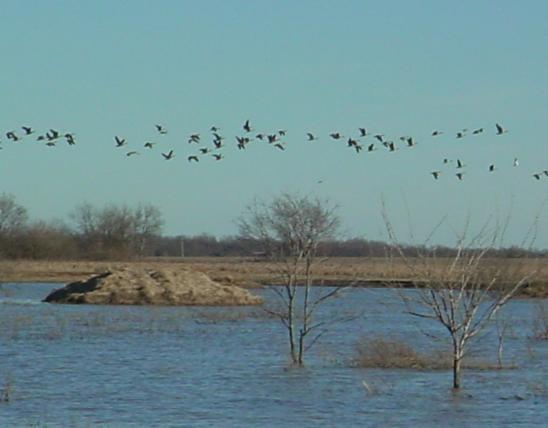
The short-eared owl is a medium-sized, heavily streaked with pale and dark browns above, and buff-white below with heavy dark streaks. The short ear tufts are difficult to see. The facial disk is pale, and the yellow eyes are surrounded with black. In flight, note the buff patch on the outer part of the upper side of the wing, and a dark crescent near the bend of the wing on the underside (the long-eared owl has a similar pattern, but it less prominent). Its characteristic flight is buoyant and butterfly-like as it flies across open fields close to the ground. Voice is varied with barks (like a small dog), hoots, squeaks, and hissing sounds — although it is usually silent on its wintering grounds in Missouri.
Similar species: Long-eared owls have tall, noticeable ear tufts and are darker, especially on the breast. Great horned owls are common in Missouri; they are larger and also have prominent ear tufts. Barred owls, also common in Missouri, also have a round-headed profile, but they have brown, not yellow eyes, and are larger. Barn owls are much lighter, with a white face and brown (not yellow) eyes. Northern harriers (which are hawks, not owls) have a similar, mothlike flight, and they also occur in grasslands. Being hawks, they have a very different body shape.
Length: 15 inches (tip of bill to tip of tail); wingspan: 3½ feet.

Statewide.
Habitat and Conservation
Open grasslands, especially native prairie. Roosts on the ground or in low bushes. Commonly active during day, especially in early morning and late afternoon, as well as at night. With careful searching you may discover a roost with up to 20 or more individuals in a ravine, in a thicket, among large hay bales, or in a dry, grassy watercourse.
Food
Mice, rats, rabbits, gophers, lemmings, insects, and occasionally birds. Hunts while flying low over grasslands, with a mothlike flight.
Status
Uncommon winter resident and migrant. Extremely rare summer resident in the Glaciated Plains, Osage Plains, and Mississippi Lowlands. In Missouri, a species of conservation concern, for its declining numbers.
Life Cycle
Nests on the ground. Apparently, it used to nest in Missouri. The ground nest sites are easily disturbed by haying or grazing, which may be the reason this species no longer nests in Missouri. Their numbers in our state are highest between October and April. The wintering range extends southward into Mexico; the year-round range is a band across the middle of North America, long the more northern US states. Summer breeding range extends far into Canada and Alaska.
Human Connections
This species is declining across the continent, mostly due to habitat loss, as the large, undivided tracts of open grasslands they require are converted to cropland, pasture, and human development (buildings and roadways). Although their situation is not nearly as dire as that of the endangered greater prairie-chicken, they both face the same problem. Hopefully, efforts to save the prairie-chicken will help this and many other grassland species, too. Conservation requires positive action on social and political levels.
Ecosystem Connections
Like other ground-nesting birds, the eggs and young are especially vulnerable to a variety of predators. Short-eared owls often nest in loose colonies, which may enable them to more quickly identify predators when they are detected. Nesting females tend to rely on their camouflage to keep them safe and will flush only as a last resort.






Where to See Species
About 350 species of birds are likely to be seen in Missouri, though nearly 400 have been recorded within our borders. Most people know a bird when they see one — it has feathers, wings, and a bill. Birds are warm-blooded, and most species can fly. Many migrate hundreds or thousands of miles. Birds lay hard-shelled eggs (often in a nest), and the parents care for the young. Many communicate with songs and calls.
































